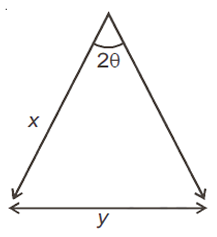 Multiple Choice Questions
Multiple Choice QuestionsA beam of light from a source L is incident normally on a plane mirror fixed at a certain distance x from the source. The beam is reflected back as a spot on a scale placed just above the source L. When the mirror is rotated through a small angle θ, the spot of the light is found to move through a distance y on the scale. The angle θ is given by
y/2x
y/x
2y/x
2y/x
A.
y/2x
When the mirror is rotated by θ angle reflected ray will be rotated by 2θ.
y/x = 2θ
θ = y/2x
A thin prism having refracting angle 10° is made of glass of refractive index 1.42. This prism is combined with another thin prism of a glass of refractive index 1.7. This combination produces dispersion without deviation. The refracting angle of second prism should be
4°
6°
8°
8°
An astronomical refracting telescope will have large angular magnification and high angular resolution when it has an objective lens of
Small focal length and large diameter
Large focal length and small diameter
Small focal length and small diameter
Large focal length and large diameter
The refractive index of the material of a prism is √2 and the angle of the prism is 30°. One of the two refracting surfaces of the prism is made a mirror inwards, by a silver coating. A beam of monochromatic light entering the prism from the other face will retrace its path (after reflection from the silvered surface) if its angle of incidence on the prism is
60°
45°
zero
30°
An object is placed at a distance of 40 cm from a concave mirror of focal length 15 cm. If the object is displaced through a distance of 20 cm towards the mirror, the displacement of the image will be
30 cm away from the mirror
36 cm away from the mirror
36 cm towards the mirror
30 cm towards the mirror
The plane face of a plano-convex lens is silvered. If μ be the refractive index and R, the radius of curvature of the curved surface, then the system will behave like a concave mirror of curvature.
μR
R2/μ
R/(μ -1)
[(μ + 1)/(μ-1)]R
A student can distinctly see the object upto a distance 15 cm. He wants to see the blackboard at a distance of 3m. Focal length and power of lens used respectively will be
-4.8cm, -3.3D
-5.8cm, -4.3D
-7.5cm, -6.3D
-15.8cm, -6.33D
A thin glass prism (μ =15) in the position of minimum deviation deviates the monochromatic light ray by 10o, the refracting angle of prism is
20o
10o
30o
45o
Two thin lenses of powers 12 D and-2D respectively are placed in contact, the power, focal length and nature
respectively will be
8D, 0.8m, convex
14D, 0.5m, convex
5D, 0.2m, convex
10D, 0.1m, convex
A prism of refractive index has a refracting angle of 60°. At what angle a ray must be incident on it so that it suffers a minimum deviation.
450
600
900
1800
